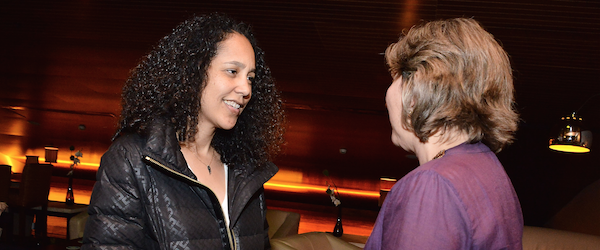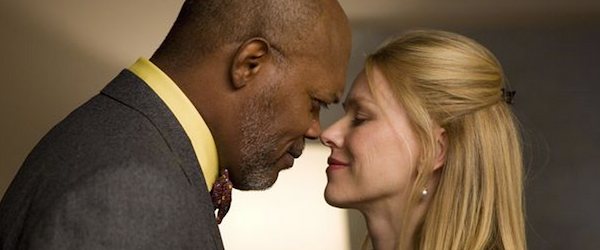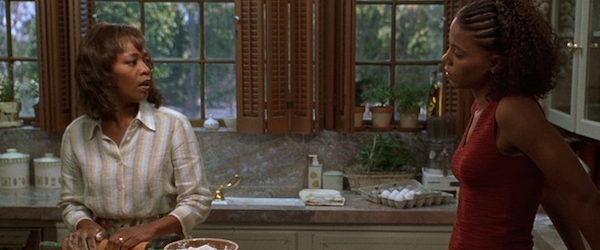14 Lessons Rodrigo Garcia and Gina Prince-Bythewood Taught Us About Working with Actors
When they met at the Sundance Directing Lab in 1998, neither Rodrigo Garcia nor Gina Prince-Bythwood had much experience working with actors. “Directing the actors, I think, is one of the great mysteries,” said Bythewood, “Especially when it’s your first film.”
But at the lab they spent a day working with acting coach Joan Darling, who forced them to confront their insecurities–and to take an acting class. Said Garcia: “She worked with us for a day and she put us through some acting exercises that I thought were absolutely terrifying.”
It’s been 18 years since that day, and with 12 feature films and numerous television credits between them, Garcia and Prince-Bythewood are a little less afraid when it comes to dealing with actors. Last month at the Los Angeles Film Festival, they sat down and shared what they’ve learned with the next generation of filmmakers.
1. Talk to the actor first
Prince-Bythewood said that to this day she still thinks of things she learned from Darling all those years ago.
“Probably one of the greatest lessons was how vulnerable an actor feels when you say cut. You’re standing there literally wondering: did you suck?” The Beyond the Lights director continued: “In film school, I used to yell direction from the back of the camera and not even talk to the actor after the take because I was too busy running talking to everyone else. She taught us that the very first person you go to, when you say cut, you go directly to the actor and you preserve that relationship.
2. And talk to the actor last
“When you cut,” added Garcia. “You speak to the actor first, then you let everything go on: the hair, the makeup people come in, the DP asks for this. So they all talk to the actor, and you should wait to talk to the actor last before the camera rolls again for take two. Because in that minute before camera rolls, the DP said, ‘Hold the glass a little higher;’ the hair person came up and said, ‘Go like this;’ the script supervisor came in and said, ‘You said three dogs, it’s two dogs.’ So [the actor] has all these things in his head or in her head and you should wait until the end. And sometimes I even wait until the slate is hit, and you give the last piece of direction, and all of a sudden that’s all they’re remembering.”
3. Loosen your grip on the script
Garcia said that perhaps the most important lesson he learned from Darling that day was that directing should arise not only from how a director sees a script, but also from how the actor performs it.
“The actors are contributing to your story and to the characters. See what they’re doing and direct from a combination of what they’re doing and what you dreamed.”

4. Put a face on your character, but don’t get too attached
Garcia said his process with actors begins before the script even starts. “When I’m writing the script, I can be writing, but until I have a model actor—this may be someone who will never say yes or I may never get—but say I’m writing something and I think about whomever—Annette Bening, I think she could be in the role—sometimes I’ll even put a picture of Annette Bening in my office, and that’s who the character is,” said the Albert Nobbs director. “By the end of the writing, I have an idea of what qualities the actor should have.”
Prince-Bythewood says she does the same thing, sometimes putting an entire cast up on the wall. “It’s really just to give the characters a voice as I’m writing.”
But for her the exercise is about more than just the qualities of a specific performer, it’s about the emotion of a moment. “For Beyond the Lights, in writing Gugu [Mbatha Raw’s] character, I actually found a picture of Rihanna and it was just a specific picture of her… that embodied a moment for that character. And it was really helpful to write to that. But I do like having a dream cast up there, and it’s not only something that inspires me, but it makes it real as well. And then it’s about going out to them and hoping that I can get them.”
But Garcia pointed out it’s best not to get too carried away.“I try not to get into that mode where, ‘Oh, it has to be Naomi Watts or no one.’ [Watts, like Bening, worked with Garcia on Mother and Child.] Because she may not be available, she may not like the script. I have an idea of the character but I want to stay fluid because who knows who it’s going to be.”
5. Know what you’re looking for in auditions
Prince Bythewood said she has four things that she needs to see in an actor in auditions.
“First, foremost is that they embody the character,” she said. “The second is that they have acting chops. I’ve worked with actors who just have natural ability but not any training and it is tough. And then you’ve got to be a cool person.” She and Garcia shared a knowing look. “We’ve worked with some nightmares and it makes you gun shy. Life is too short to work with people that don’t respect the process.”
Prince-Bythewood said conversations that she has with actors after the audition can be crucial in determining whether they’ll click.
And her last quality? “Work ethic. I want to know that you are going to go to the ends of the earth for this character, whatever it takes. It could be as small as cutting your hair. Are you willing to cut your hair for it? Are you willing train for six months to learn basketball like Sanaa [Lathan, star of Love and Basketball] did?”
6. Do your homework
And if you’re not sure, even after the audition, whether or not an actor has these qualities? Call someone who has worked with that person.
“I think that’s crucial to make phone calls and really find out,” said Garcia. “And give up on these dreams you have, ‘Oh I’ve always dreamed of working with so-and-so.’ Well so-and-so could ruin your life. So really make phone calls.”

7. Rehearsal can be as helpful for the director as it is for the actors
On the subject of rehearsal, Prince-Bythewood and Garcia didn’t entirely agree. Prince-Bythewood said she loves it.
“For me rehearsal is a lot of making sure that actors understand their characters,” she said. “But rehearsal is not just for the actors; it’s for me too as a director, wanting to know what I need to do to get them there on set, but also how I’m going to shoot it as well.”
8. Often, less direction is better direction
Garcia tries to rehearse as little as possible. And sometimes he still finds himself over-directing.
“One of the best directing lessons that I had was on the first movie I did [Things You Can Tell Just By Looking At Her]. Callista Flockhart had a scene where she played the girlfriend of a woman who was sick, and at one point she went to the kitchen, came back, and discovered that the girl had died while she was in the kitchen. It was a comedy.”
Then Garcia got serious: “We do take one and I’m going to say something to her and she says, ‘Don’t say anything to me, I don’t want you in my head yet.’”
Garcia said he thinks of that sentence often. “I always try to delay direction as much as I can. I try to see what the actor does in take one, maybe in take two. In take three I start giving a little direction to see what happens if we go in one [way] or another.”
9. Don’t bullshit Alfre Woodard
“I will say, in terms of one of those great lessons from my first film,” said Prince-Bythewood, “Alfre Woodard taught me an amazing lesson. We rehearsed the scene and she did it, and she was just okay, but it’s Alfre Woodard, and I was scared of her and I said, ‘That was great!’ And she just looked at me and she said, ‘No it wasn’t,’ and she said, ‘Now I can never trust you.’ And it just so freaked me out. But it was the best thing she could say to me because I never lied to her again.”
Garcia nodded. “She was saying, ‘Don’t bullshit me, Gina.’”
“Exactly,” Bythewood agreed. “Because I am her eyes and ears and the barometer of whether she was good or not and you cannot lie to an actor… They have to trust that if they’re going to give everything, that they’re getting that back in return.”

10. Sometimes it’s best to get the tricky scenes out of the way early
Luckily, Woodard only had Prince-Bythewood’s best interest at heart. But what do you do if your relationship with an actor deteriorates in the middle of production? Prince-Bythewood said it happened to her on one of her early films.
“The issue was that he was really nice to the lead actress until he realized she wouldn’t sleep with him, and then he became a raging asshole,” she said. “And so, as a director, now I have to get a performance out of this guy that I dislike. But I also have to protect my lead actress, and that was the really tough thing because he really was mean to her. And they had to do love scenes. That was another thing that I learned: I love shooting in order, but if you can, schedule your love scenes early on, because normally there is a little bit of flirtation early on. You never know where the relationship is going to go.”
11. And sometimes you have to get it all out in the open
Garcia said when he’s having a hard time with someone on set, he tries to be as direct as possible. “What I do try to do is face it and voice it and not let it get bottled up,” he said. “I don’t do well with conflict, but it’s necessary, so I will say, ‘What’s going on? What’s wrong with the scene? Why are you behaving like an asshole? Why are you treating her like that?’”
Prince-Bythewood’s jaw dropped a little bit. “You literally say that?”
“Sometimes I do. I say, ‘What is up your ass?’ There’s a point where things are bad. So I think venting, and also letting them know that I’m pissed off, is better than when nobody speaks and everything’s bottled up. And I honestly think… most problems improve with a ten minute conversation.”
12. But most actors work very hard
“I’m always pleasantly reminded how much work they put into it,” said Garcia. “There are some lazy actors and some lazy stars, but they mostly come to the set and they’ll ask you something about one line of dialogue that you have never really thought of. And they read it and read it and read it and thought about it and read it again. So I would say, as a rule, it’s not a very lazy profession.”
13. Give them the freedom to show you something
Prince-Bythewood stressed the importance of the director having a vision, but said it might be even more important to let the actor create.
“In the first rehearsal I don’t give any direction at all,” she said. “Give the actors the freedom. I say, ‘Show me what you’ve come up with. Because I’m hoping, honestly, that it’s better. It’s just going to make me look good. Show me something I didn’t think before. And if it’s totally off and might need adjustment or something, then I step in, but at least give them the freedom to show you something.
14. And pay attention so you don’t miss it
Garcia said he’s seen the fruits of letting actors build characters on their own. He told a story of Kerry Washington discovering a whole new dimension of a character and putting it into the performance without discussing it.
“Sometimes actors do things and I’m like, ‘Oh, what was that?’ And before I say, ‘No, that doesn’t work,’ I’ll try to process it,” said Garcia. “You have to—especially with the good actors—pay a lot of attention. Because they might be doing something they haven’t told you, and you don’t want to miss it.”
Tom Sveen / Film Independent Blogger